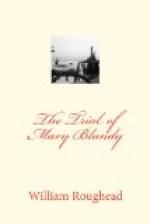Of the earlier phases of Francis Blandy’s fatal illness, which began in this month of June, the evidence tells us nothing more definite than that he suffered much internal pain and frequently was sick; but two incidents occurring at that time throw some light upon the cause of his complaint. It was the habit of the old man to have his tea served “in a different dish from the rest of the family.” One morning Susan Gunnell, finding that her master had left his tea untasted, drank it; for three days she was violently sick and continued unwell for a week. On another occasion Mr. Blandy’s tea being again untouched by him, it was given to an old charwoman named Ann Emmet, often employed about the house. She shortly was seized with sickness so severe as to endanger her life. That Mary knew of both these mysterious attacks is proved; she was much concerned at the illness of the charwoman, who was a favourite of hers, and she sent white wine, whey, and broth for the invalid’s use.
It is singular that such experiences failed to shake Miss Blandy’s faith in the harmless nature of Mrs. Morgan’s nostrum, but they at least made her realise that tea was an unsuitable vehicle for its exhibition, and she communicated the fact to Cranstoun. Her bloodthirsty adviser, however, was able to meet the difficulty. On 18th July he wrote to her, “in an allegorical manner,” as follows:—“I am sorry there are such occasions to clean your pebbles; you must make use of the powder to them by putting it in anything of substance wherein it will not swim a-top of the water, of which I wrote to you in one of my last. I am afraid it will be too weak to take off their rust, or at least it will take too long a time.” As a further inducement to her to hasten the work in hand, he described the beauties of Scotland, and mentioned that his mother, Lady Cranstoun, was having an apartment specially fitted up at Lennel House for Mary’s use. The text of this letter was quoted by Bathurst in his opening speech for the Crown, but the report of the trial does not bear that the document itself was produced, or that it was proved to be in Cranstoun’s handwriting. The letter is quoted in the Secret History and referred to in other contemporary tracts, and the fact of its existence appears to have been well known at the time. Further, Miss Blandy in her Own Account distinctly alludes to its receipt, and no objection was taken




